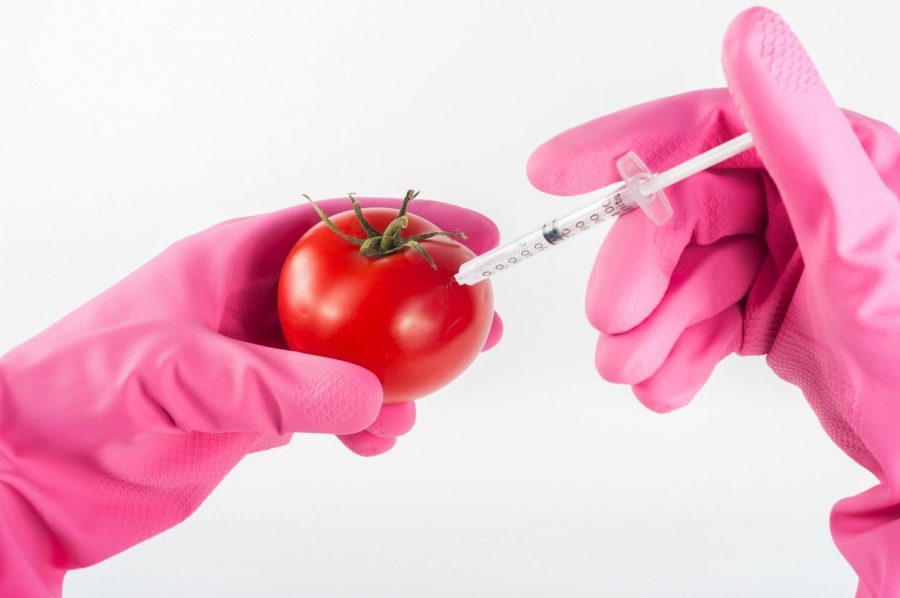Cooking and Commodities: GMO or No?
Despite their negative associations in the media, genetically modified organisms hold great potential to cure world hunger.
There is a lot of misinformation and controversy surrounding GMOs.
December 20, 2021
Organic, ‘All-Natural,’ GMO Free, unprocessed, local. All these terms are used within the food industry quite commonly, and yet are mostly mere marketing tools. Though I have no doubt that many companies use these terms with good intent, plenty still use the power of these words to deceive their customers into continuing to buy from them.
GMOs, in particular, are seemingly the arch-enemy of both conservative eaters and liberal hipsters browsing local food stands. Yet, these organisms may be the key to fighting world hunger.
What are Genetically Modified Organisms? Many definitions exist but generally meet along the lines of “an organism that has had its genes, in some capacity, edited by humans.”
This has resulted in, of course, large debates over whether selective breeding, which we’ve been mastering since we learned to grow food, can be considered a process of creating GMOs. Either way, it does not change the nature of GMOs and their incredible potential.
How? Well, through the process of editing genes. Either by removing, replacing, or a similar operation, we can create and have created food of the future. Examples of this include food that has a longer shelf life, food capable of defending itself (no need for pesticides), faster growing plants, nutrient reinforced food, and even making food tastier.
Of course, we must be vigilant and wary of possible downsides. Dangerous edits to food can result in detriments to either the consumer or the food itself. Still, like all sciences, the process takes time and must be heavily tested.
You have probably eaten or used a few genetically tinkered-with products, but the biggest impact they have had is in developing nations. In Uganda, not only do people love bananas (the average Ugandan eats 2-3x their body weight in bananas every year), they also survive off of banana exports and sales.
However, during the mid-2000s, a disease emerged called “Xanthomas Wilt,” or BMX. This disease ravaged many fields, family farms, and large freeholds, killing off a large portion of the nation’s sustaining crop, and in many cases, wiping out upwards of 80% of a field’s crop. Luckily, scientists from the International Institute of Tropical Agriculture and the African Agricultural Technology Foundation synthesized bananas immune to BMX using genes from sweet peppers in 2011. This saved many small farmers, and today, Uganda is the second largest exporter of bananas in the world. Interestingly, the wealthier a community was, the more opposed to these genetically modified bananas they were.
So why all the hate? The problem may lie with unregulated, free market capitalism.
Seed and chemical firms have used GMOs to make a profit. The Monsanto corporation is the most widely known example of GMO abuse. Producing products such as Agent Orange, they first made their profit from the sale of pesticides.
When it turned out some plants had issues with a particular pesticide, they engineered plants that were able to defend themselves from the pesticide. The most famous example was the herbicide Roundup, and the plants engineered to be resistant to it were called Roundup Ready. The crop itself was not called Roundup Ready, but they patented the genetically engineered seeds as Roundup Ready.
Roundup was already widespread by the time it was produced and sold separately from Roundup Ready. This resulted in farmers not only being dependent on Roundup but also being forced to buy Roundup Ready if they wanted healthy crops. If they wanted to buy another brand, tough luck — the seeds are patented.
This wasn’t the only issue with Roundup. Studies showed that several of the key ingredients in Roundup are carcinogenic.
What did Monsanto do with the information that one of their highest selling products could cause cancer? Suppress the information, of course! They couldn’t let pesky safety get in the way of making a profit.
Although Monsanto has since gone defunct after its criminal actions were exposed, similar corporations use the same tactics, ruining the name of GMOs. The term has become so negative that even salt is sometimes labeled as GMO-free, despite salt literally being a mineral with no genes in the first place to be edited.
Ultimately, what should be done? It is clear that through extensive scientific research, testing, and practice, GMOs could solve many food-related problems. With the inevitably changing climate, this becomes even more true. It is up to the world to decide. Do we regulate genetic engineering to state-owned firms only? Do we simply let the invisible hand of the free market find a solution? Do we say the risks are too big and look for solutions other than GMOs?
What is clear is that GMOs are more than just a marketing ploy. They could provide us with a sustainable, healthy, and happy future.













